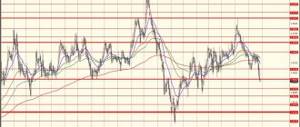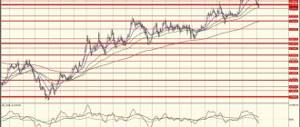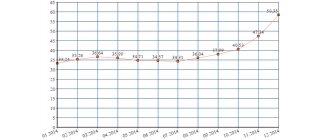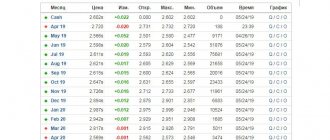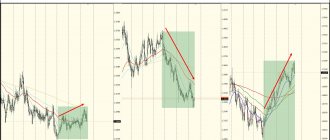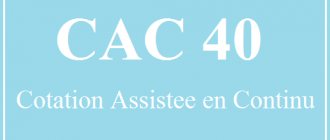DASH to US dollar exchange rate (DASH/USD) today. Dash (Dash) DASH/USD quotes online. Streaming graph in real time. Cryptocurrency charts online. The time on the DASH/USD cryptocurrency exchange rate chart is Moscow GMT+3. KRAKEN exchange data. DASH chart is daily. One division (one candle) is one day. The timeframe (time interval of quotes on the chart) can be changed independently, in the upper left part of the chart. From 1 minute to 1 month. There is no need to update the DASH/USD chart online, prices are received in real time. All you have to do is save the page to your favorites so that you can return to it and, if necessary, find out the current DASH to US dollar rate. To save a page as a favorite, press the keyboard shortcut Ctrl+D. Press the Ctrl key and, without releasing it, press the D key.
(wait a few seconds after the page loads - the graph will appear)
Find any chart you need online:
FOREX CHARTS
¢ EUR USD Chart ¢ USD CHF Chart ¢ AUD USD Chart
¢ NZD USD chart ¢ GBP USD chart ¢ USD CAD chart
¢ USD JPY chart ¢ USD ILS chart ¢ EUR ILS chart
¢ USD RUB chart ¢ USD UAH chart ¢ USD KZT chart
All forex charts CRYPTOCURRENCY CHARTS
Ω Bitcoin chart Ω Ethereum chart Ω Litecoin chart
Ω Bitcoin Cash chart Ω Ripple chart Ω Zcash chart
Ω Monero Chart Ω Dash Chart Ω IOTA Chart
Ω EOS chart Ω Ethereum Classic chart Ω Waves
chart All cryptocurrency charts STOCK INDEX CHARTS
Θ RTS chart Θ Dow Jones chart
Θ NASDAQ 100 chart Θ FTSE-100 chart
Θ DAX Chart Θ Nikkei 225 Chart
Θ Standard and Poor's 500
chart All stock indices COMMODITY CHARTS
Ξ Gold chart Ξ Gold chart in rubles
Ξ BRENT Oil Chart Ξ Oil Chart in Rubles
Ξ Silver Chart Ξ Natural Gas Chart
Ξ Copper Chart Ξ Platinum Chart
All Commodities
Characteristics of the Dash cryptocurrency
The characteristics of the Dash cryptocurrency require special clarification. It has a long series of features, each of which is described in lengthy articles from experts. We will simply highlight the main “features” of the project that attract ordinary users to purchase Dash:
- The project’s blockchain allows for almost instant transfers.
- Transaction fees are minimal, making Dash an excellent means of payment, on par with fiat.
- There are already thousands of serious companies in various fields operating in the world that accept payments in Dash, because it is convenient and fast (the list can be found on the official website).
- The coin is traded on most popular exchangers and exchanges in the world.
- The project initially positions itself as the best alternative to regular money.
- The PrivateSend function (private anonymous sending of cryptocurrency) is implemented inside the blockchain, which allows you to completely disable the ability to track a transaction.
- Dash can be transferred both anonymously and non-anonymously (for the first option you will need to pay an additional commission).
The coin has millions of fans, and in some countries (for example Venezuela) it is already actively fighting for popularity with the local weak state currency
What is Dash
Dash
(formerly known as Darkcoin and XCoin) is an open, decentralized payment system that uses a mechanism called "Darksend" to make transactions anonymous. The Dash cryptocurrency project (DASH, Dash, in Russian you can say “Dasha”) is one of the most promising among altcoins. It successfully brought together active and qualified programmers who took the best from Bitcoin and existing forks, adding their own unique developments. The community appreciated the promising idea.
More than a year and a half has passed since the launch; During this time, Dash rapidly gained popularity, becoming one of the top five leading cryptocurrencies. The launch of the cryptocurrency, which at that time was called Xcoin, occurred on January 18, 2014, and from January 28, 2014 to March 25, 2015, it bore the name Darkcoin, under which it gained a significant share of popularity. Not everything worked out right away, as the developer, Evan Duffield, initially wrote the code alone. Soon, a full-fledged team of enthusiasts was formed, several new releases were released, improving the anonymity mechanisms of DarkSend and optimizing the operation of the Masternode network. In the fall of 2014, Dash successfully passed a security audit by recognized expert Kristov Atlas, after which the source code was opened. Later, the functionality of instant transactions InstantX was implemented.
In March 2015, the “dark horse” of the cryptocurrency world rebranded, changing its name to DASH - while all other components of the project remained unchanged. The general desire to remain the No. 1 anonymous cryptocurrency has also been preserved. The new name DASH plays on the words “dash”, one of the meanings of which is “rapid movement, jerk” and “digital cash”, that is, digital money. Along the way, the word “coin”, generally accepted for most forks, disappeared from the name. Dash has set itself the following goal: to become a direct competitor to Bitcoin.
How to store Dash
The question of how to store Dash conveniently and safely is very important. To do this, we recommend using the following services:
- an online exchanger with the Matbea wallet function (if the ability to purchase for rubles, increased security, dozens of wallets on one account, affiliate earnings and transfer of Dash from wallet to wallet without interest is important);
- top cryptocurrency exchanges: Binance, Coinbase, Huobi (if the difficulties, check and verification procedures, problems with ruble purchases are not very critical);
- wallets from the recommendations section on the official website - Get Started - Downloads (if you just need storage, and purchases will be made elsewhere).
Matbi is a cryptocurrency wallet and exchanger,
we have been working since 2014
Dash Features
Dasha has several original features that distinguish it from Bitcoin and many faceless forks that can only boast of changing the name, logo and key constants.
The basis for all of Dash's key features is its two-tier distributed network architecture. Bitcoin's traditional peer-to-peer network is based on peer-to-peer consensus, which results in verified transactions being recorded on a distributed ledger (blockchain).
The two-tier Dash network works differently - “supernodes” form the top layer of real-time consensus. This speeds up the protocol, but slightly increases security risks. After which, transactions approved by masternodes undergo the same procedure of recording in the blockchain through mining.
In the future, the capabilities of the two-level Dash network can be used to implement solutions such as Distributed Storage Systems (transaction lists, registries, messages, etc.), Distributed Application Systems (exchanges, stores, services, etc.), support for Third Party projects, etc.
The future development of Dash will be determined by the voting system currently being implemented. This new tool for the cryptocurrency world will allow Dash to conduct distributed secret voting between masternodes. “Ordinary” network users do not have the right to vote, but any of them can put forward proposals for development.
Thus, Dash is creating a platform that is maximally suitable for further effective development, adaptation and promotion of new cryptocurrency technologies.
Weighted average Dash rate
Now the weighted average rate of Dash is significantly lower than its peak values (in 2017, the coin cost more than $1,500). Nevertheless, the course has prospects.
Many experts believe that now is the time when it is better to buy Dash and switch to a strategy of waiting for growth. The only thing that could hinder future success is the challenge of regulators who criticize the use of Dash due to its reliable anonymous transfer feature.
Darksend
If Bitcoin is legal in your country, then you can use Dash on the same legal grounds. The difference is that the confidentiality of transactions in BTC requires the use of additional measures (using different addresses for each transaction, IP masking and other methods). And all the functionality that allows you to mix coins and thereby achieve maximum anonymity of payments is built into Dash from the very beginning.
The Darksend feature is disabled by default because there is a separate small fee for using it. When enabled, you can set from 2 to 8 rounds of mixing coins. The number of coins that must be mixed is also set there.
Anonymization occurs in advance and in the background. Before mixing, “denomination” occurs - that is, the entire amount is divided into equal denominations: 0.1, 1, 10, 100 DASH - and only then each such “standard bill” goes through all rounds of mixing independently. At the moment when you need to actually make an anonymous payment, you will be able to do this instantly and independently, without waiting for other suitable partners in the joint transaction.
How to make money on Dash
Now on the Internet you can find dozens of working methods that explain how to make money on Dash. We recommend that you read the articles that will describe the use of some of them:
- The article mining on video cards will tell you how you can use mining on the device of an individual PC or an entire farm.
- Material Future of Bitcoin will share forecasts and options on how to make money by investing in “digital gold” and receive funds for Dash.
- The article browser mining will give an understanding of mining through a regular browser, which is used by people every day without any special financial profits.
Digital Cash cryptocurrency features
The Dash organization system is significantly different from other cryptocurrencies. Essentially, it operates on the principles of decentralized autonomous organizations (DAOs).
There are other features that determine the operating principles of cryptocurrency. Here are some of them:
- The maximum emission is limited.
- Dash production will end in 2150.
- The volume of cryptocurrency produced will decrease by 7% every year. Until it approaches 0 in 2150.
- A two-level system of miners and master nodes ensures security in the network.
- The consent of the master nodes is necessary to confirm the mining of the block by the miners.
- The mining reward is divided between master nodes and miners, with master nodes receiving about 45%.
- A new block appears approximately every 2 and a half minutes.
- The established block reward is 5 Dash.
Mining DASH
Dash mining uses a combination of the X11 multi-hashing algorithm and the DarkGravityWave difficulty regulation mechanism (a special implementation of the KGW technology - Kimoto Gravity Well). With DarkGravityWave, difficulty changes more smoothly and currency prices experience fewer fluctuations. The reward for a block depends on the difficulty and is calculated using the formula 2222222/(((Difficulty+2600)/9)^2). Now the reward is approximately 6 DASH per block.
The X11 algorithm is a combination of 11 hashing algorithms ((blake, bmw, groestl, jh, keccak, skein, luffa, cubehash, shavite, simd, echo). Network failure will only occur if all 11 algorithms are hacked, which is unlikely. Even if attackers It will be possible to break several algorithms, this will give developers time to take action and replace the compromised functions.
Dash is currently mined using central processing units (CPUs) and graphics processors (GPUs), with a preference for the latter. Mining with GPUs using the X11 algorithm requires 40-50% less energy than using the Scrypt algorithm. Also, for this reason, the heat dissipation of the card drops by 40-50%.
Is an ASIC possible for X11? Such developments are already underway. Developer Evan Duffield has repeatedly emphasized that DASH cannot be called ASIC-protected. In his opinion, Dash is going to follow the same path that Bitcoin and Litecoin did before him - mining on a CPU, moving to a GPU and then to an ASIC.
Masternodes
The so-called “masternodes” are the main nodes of the Dash network, which are the basis of its stability and security and perform service functions. For example, masternodes act as guarantors, confirming transactions sent using InstantX without waiting for them to be included in blocks. The masternode system is discussed in detail on the Dashtalk website. Each masternode, among other things, is a “mixer” that mixes (optional) user transactions to operate the Darksend mechanism.
The system rewards masternode operators - they now account for 50% of the bonus for creating new blocks, and from version 0.12 they decided to leave this value constant. To be precise, a deduction was made from the total amount of the issue for the development of the network. To achieve this, the total issue of coins has been reduced by 10%. Masternodes and miners finance promising proposals by deducting 10% from their “former” income: according to the old emission scheme, 45% goes to miners, 45% to masternodes, and 10% goes to development.
If any improvement proposal is accepted through the voting system, funding will be generated by generating a "super block" once a month. If there are no offers worthy of payment, then these coins simply will not appear in the system and 10% less new DASH will be created.
To create a new Masternode, a “deposit” of 1000 DASH is provided, which must be on the node’s wallet (but can be spent by the owner at any time, which will entail the shutdown of the Masternode). Now there are almost 3000 nodes.
Such a high deposit was introduced in order to protect the network from possible attacks (the so-called “51%” attack), and does not allow ill-wishers to gain control over a significant part of the network, including the voting system. If you try to buy a large number of coins on the market, their price will rise significantly. Thus, on the one hand, the system is open to the creation of new masternodes, and on the other hand, it limits the ability of individual players to control a significant part of the network and interfere with its work.
The maximum number of masternodes is naturally limited by the number of DASH already mined. Now this is approximately 5,600 pieces - that is, now more than 40% of all available coins are blocked for the functioning of supernodes. On the one hand, this creates a shortage of Dash and increases their value on exchanges, but on the other hand, developers become hostages of the current scheme, since if the size of the collateral changes - in any direction - a significant amount of DASH will spill onto the market, which can lead to strong fluctuations in the rate .

